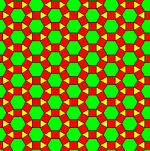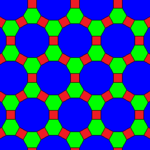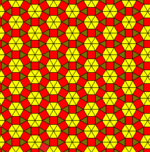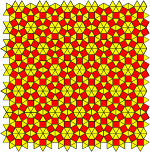User:Tomruen/t-isohedral tilings
Appearance
k-uniform tilings, edge-to-edge tilings of regular polygons, can be regrouped as t-isohedral tilings. 1, 2 and 3-uniform tilings are grouped below.
Face figures and notation
[edit]A face figure defines the edge-to-edge connectivity of a t-isohedral tiling. The notation n:a1.a2...an implies a regular n-gon surrounded by regular faces in sequence of sides a1, a2, ...an.
| n:mn | 3 | 4 | 6 | 8 | 12 |
|---|---|---|---|---|---|
| 3 |  3:33 |
 3:43 |
 3:63 |
 3:123 | |
| 4 |  4:34 |
 4:44 |
 4:84 |
||
| 6 |  6:36 |
 6:46 |
 6:66 |
| 4 |  4:(3.4)2 |
 4:(3.6)2 |
 4:(6.12)2 |
|---|---|---|---|
| 6 |  6:(4.12)3 |
 6:(3.6)3 | |
| 8 |  8:(4.8)4 | ||
| 12 |  12:(3.12)6 |
 12:(4.6)6 |
| 3 |  3:32.4 |
 3:3.42 |
 3:32.6 |
 3:3.62 |
 3:42.6 |
 3:4.62 |
 3:4.122 | |
|---|---|---|---|---|---|---|---|---|
| 4 |  4:3.43 |
 4:3.42.6 |
 4:3.4.6.4 | |||||
| 6 |  6:32.64 |
 6:3.6.3.63 |
 6:(3.3.6)2 |
 6:(3.6.6)2 |
 6:3.65 |
 6:35.6 |
 6:(32.4)2 |
 6:(3.42)2 |
| 12 |
1-isohedral tilings
[edit]| p6m, (*632) | p4m, (*442) | |
|---|---|---|
 36 [3:33] (k=1, t=1, e=1) 
|
 63 [6:66] (k=1, t=1, e=1) 
|
 44 [4:44] (k=1, t=1, e=1) 
|
2-isohedral tilings
[edit]| p6m, (*632) | p4m, (*442) | p4, (442) | ||
|---|---|---|---|---|
 (k=2, t=2, e=1) [3:63; 6:36]  
|
 (k=1, t=2, e=2) [3:63; 12:(3.12)6]  
|
 (k=1, t=2, e=2) [4:84; 8:(4.8)4]  
|
 (k=1, t=2, e=2) [3:3.42; 4:34]  
|
|
| cmm, (2*22) | p6m, (*632) | pmm, (*2222) | cmm, (2*22) | |
 (k=1, t=2, e=3) [3:32.4; 4:(3.4)2]  
|
 (k=2, t=2, e=3) [3:32.6; 6:(3.6)3]  
|
 (k=2, t=2, e=3) [3:3.62; 6:(3.3.6)2] |
 (k=2, t=2, e=4) [3:32.6; 6:(3.3.6)2]  |
 (k=2, t=2, e=4) [3:32.4; 4:3.44]  
|
| cmm, (2*22) | p6m, (*632) | |||
 (k=3, t=2, e=4) [3:3.62; 6:3264] 
|
 (k=3, t=2, e=5) [3:32.6; 6:(3.6.6)2]  
|
 (k=3, t=2, e=3) [3:32.6; 6:(3.6.6)2]  
|
 (k=4, t=2, e=5) [3:32.6; 6:3.65]  
| |
3-isohedral tilings
[edit]| p6m, (*632) | p6, (632) | |||
|---|---|---|---|---|
 (k=1, t=3, e=2) [3:43; 4:(3.6)2; 6:46]  , ,
|
 (k=1, t=3, e=3) [4:(6.12)2; 6:(4.12)3; 12:(4.6)6]  , , |
 (k=2, t=3, e=3) [3:32.4; 3:43; 4:34] 
|
 (k=2, t=3, e=3) [3:33; 3:32.6; 6:36]  
|
 (k=1, t=3, e=3) [3:33; 3:32.6; 6:36]  
|
| p4m, (*442) | pgg, (2*22) | pmm, (*2222) | pgg, (2*22) | |
 (k=2, t=3, e=3) [3:4.122; 4:34; 12:(32.12)4]  
|
 (k=2, t=3, e=4) [3:4.62; 4:3.4.6.4; 6:(32.4)2]  
|
 (k=2, t=3, e=4) [3:33; 3:32.4; 4:(3.4)2] |
 (k=2, t=3, e=5) [3:32.4; 3:3.42; 4:44] 
|
|
 (k=3, t=3, e=4) [3:33; 3:32.6; 6:36]  
|
 (k=3, t=3, e=5) [3:3.62; 3:63; 6:35.6] 
|
 (k=3, t=3, e=6) [3:32.4; 4:3.43; 4:44] 
|
 (k=3, t=3, e=4) [3:42.6; 4:3.42.6; 6:(3.42)2]   | |
 (k=3, t=3, e=5) [3:33; 3:32.6; 6:(32.6)2]  |
 (k=3, t=3, e=6) [3:33; 3:32.6; 6:(32.6)2]  |
 (k=3, t=3, e=3) [3:33; 3:32.6; 6:36] 
|
 (k=3, t=3, e=5) [3:33; 3:32.4; 4:3.43] | |
4-isohedral tilings
[edit]5-isohedral tilings
[edit]| p6m, (*632) | p6, (632) | ||||
|---|---|---|---|---|---|
 (k=2, t=5, e=5) [3:42.6; 4:(4.6)2; 4:3.4.3.6; 6:46; 6:(3.4)3] File:Face figure 3 446.svgFile:Face figure 4 4646.svgFile:Face figure 4 3436.svg |
 (k=2, t=5, e=7) [] | ||||
 (k=3, t=5, e=5) |
 ] ](k=3, t=5, e=6) |
 (k=3, t=5, e=7) |
 (k=3, t=5, e=8) |
 (k=3, t=5, e=7) | |
 (k=3, t=5, e=6) |
 < <(k=3, t=5, e=6) |
 (k=3, t=5, e=6) |
 (k=3, t=5, e=6) |
 (k=3, t=5, e=6) | |
 (k=3, t=5, e=6) |
 (k=3, t=5, e=6) |
 (k=3, t=5, e=6) |
 (k=3, t=5, e=7) |
 (k=3, t=5, e=6) | |
 (k=3, t=5, e=8) |
 (k=3, t=5, e=7) |
 (k=3, t=5, e=7) |
 (k=3, t=5, e=8) |
 (k=3, t=5, e=6) |
 (k=3, t=5, e=7) |
6-isohedral tilings
[edit] (k=3, t=6, e=6) |
 (k=3, t=6, e=8) |
 (k=3, t=6, e=7) |
 (k=3, t=6, e=7) |
 (k=3, t=6, e=9) |
 (k=3, t=6, e=8) |
 (k=3, t=6, e=7) |
 (k=3, t=6, e=6) |
 (k=3, t=6, e=6) |
 (k=3, t=6, e=7) |
7-isohedral tilings
[edit] (k=3, t=7, e=9) |
References
[edit]- Chavey, D. (1989). "Tilings by Regular Polygons—II: A Catalog of Tilings". Computers & Mathematics with Applications. 17: 147–165. doi:10.1016/0898-1221(89)90156-9.
- n-uniform tilings Brian Galebach


























